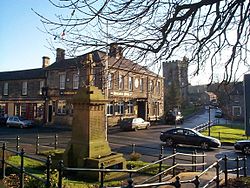Rothbury
| Rothbury | |
| Northumberland | |
|---|---|
 Rothbury town centre | |
| Location | |
| Grid reference: | NU056017 |
| Location: | 55°18’35"N, 1°54’39"W |
| Data | |
| Population: | 1,740 (2001) |
| Post town: | Morpeth |
| Postcode: | NE65 |
| Dialling code: | 01669 |
| Local Government | |
| Council: | Northumberland |
| Parliamentary constituency: |
Berwick-upon-Tweed |
Rothbury is a town in Northumberland, on the banks of the River Coquet 13½ miles north-west of Morpeth and 26 miles north-north-west of the county's greatest town, Newcastle upon Tyne. At the time of the 2001 census, Rothbury had a population of 1,740.
Rothbury emerged as a relatively important town in the historic district of Coquetdale because of its situation at a crossroads over a ford along the River Coquet. Turnpike roads leading to Newcastle upon Tyne, Alnwick, Hexham and Morpeth allowed for an influx of families and the enlargement of the settlement during the Middle Ages. Rothbury was chartered as a market town in 1291, and became a centre for dealing in cattle and wool for the surrounding villages well into the Early Modern Period.
Today, the town is used as a staging point for recreational walking. Landmarks in and around Rothbury include the Victorian-era mansion Cragside, the Simonside Hills and Northumberland National Park.
History
The first mention of Rothbury, according to a local history,[1] was in around the year 1100, as Routhebiria, or "Routha's town" ("Hrotha", according to Beckensall).[2] Fragments from an Anglo-Saxon cross, believed to be 8th century, are the only surviving relics pre-dating the Norman conquest. They are now in the town church and the University of Newcastle Museum.
The village was retained as a Crown possession after the conquest, being made over to the Lords of Warkworth in 1204. Rothbury was a relatively important village in Coquetdale, being a crossroads situated on a ford of the River Coquet, with turnpike roads leading to Newcastle upon Tyne, Alnwick, Hexham and Morpeth. It was chartered as a market town in 1291, and became a centre for dealing in cattle and wool for the surrounding villages. A market cross was erected in 1722, but demolished in 1827. In the 1760s, according to Bishop Pococke, the village also had a small craft industry, including hatters. At that time, the village's vicarage and living was in the gift of the Bishop of Carlisle, and worth £500 a year.
Rothbury has had a turbulent and bloody history. In the fifteenth and sixteenth centuries the Coquet Valley was a pillaging ground for bands of Reivers who attacked and burned the town with terrifying frequency. Near the town's All Saints' Parish Church stands the doorway and site of the seventeenth century Three Half Moons Inn, where the Earl of Derwentwater stayed with his followers in 1715 before marching into a heavy defeat at the Battle of Preston.
Hill farming has been a mainstay of the local economy for many generations. Names such as Armstrong, Charleton and Robson remain well represented in the farming community. Their forebears, members of the reiver 'clans', were in constant conflict with their neighbours and their Scots counterparts. The many fortified farms, known as bastle houses, are reminders of troubled times which lasted until the unification of the kingdoms in 1603.
The industrialist Lord Armstrong (1810–1900) helped shape modern Rothbury. Many local buildings reflect his Victorian style and prosperity. At the same time the planting of more than six million trees and shrubs transformed the surrounding landscape. His magnificent home at Cragside, now in the care of the National Trust, is visited by more than 150,000 people annually.
Until 1965, Rothbury was the location of a racecourse, which staged only one meeting per year, in April.
Parish church

Rothbury's parish church is All Saints' Church. It dates from circa 1850, largely replacing but in parts incorporating the fabric of a former Anglo-Saxon church, including the chancel, the east wall of the south transept and the chancel arch. The church has a font with a stem or pedestal using a section of the Anglo-Saxon cross shaft, showing what is reputed to be the earliest carved representation in Great Britain of the Ascension of Christ.[3]
Sights of the town
A market cross stands near the church, of which the current version of which was erected in 1902. It is known as "St Armstrong's Cross" as it was paid for by Lady Armstrong, widow of Lord Armstrong of Cragside.[4]
Half a mile to the south, Whitton Tower is an exceptionally well-preserved 14th-century pele tower.[5]
Lordenshaw Hill has the largest concentration of rock carvings in Northumberland. Over 100 panels have been recorded on the hill, the adjacent Whitton Burn and Garleigh Moor, in an area which covers less than a square mile. The carved panels range from single cup-marked boulders to complex panels. There are many other interesting archaeological sites in this area, including a ditched Iron Age enclosure and an Early Bronze Age cairn.[6]
Transport
The town was the terminus of a branch line from Scotsgap railway station on the North British Railway line from Morpeth to Reedsmouth. The last passenger trains ran on 15 September 1952 and the line closed completely on 9 November 1963. The town is now served by a bus service which runs via Longframlington, Longhorsley, Morpeth and continues to Newcastle upon Tyne, the nearest city.
Outside links
| ("Wikimedia Commons" has material about Rothbury) |
- Rothbury: The Village
- Rothbury Photos
- Northumbrian Railways
- Cragside - National Trust
- Information on Rothbury from GENUKI
- Northumberland Communities
References
- ↑ Frank Graham (1975) Rothbury and Coquetdale. Northern History Booklet No. 65. ISBN 0-85983-092-6.
- ↑ Stan Beckensall (2001) Northumberland The Power of Place. Tempus Publishing Ltd ISBN 0-7524-1907-2.
- ↑ [1]; see also [2]
- ↑ Know your parish
- ↑ National Monuments Record: No. 4409 – Whitton Tower
- ↑ "Walking With Rock Art - 7. Lordenshaw" at rockart.ncl.ac.uk